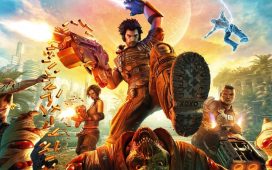Deathtrap Dungeon’s original release is arguably a pivotal moment for many working in the industry. And Good Gate Media’s John Giwa-Amu’s recollection of the early Fighting Fantasy titles certainly resonated with us:
“This all started for me with those little penguin boxes, a lady used to come around our school to sell. And that was, Citadel of Chaos, Forest of Thieves or Deathtrap Dungeon. And they stuck in my head for nearly 40 years. And after seeing what the guys at Wales Interactive were doing [with interactive FMV], I just thought this may be the time to start pushing the genre out a little bit and seeing what actually can be achieved and what audiences really are hungry for.”
The first port of call was Ian Livingstone, to negotiate the rights, which took a while to work out. However, the real hurdle was the budget required to do justice to the book, as the fantasy genre is not a cheap one to work in, says Giwa-Amu.
“In terms of making something like this, we knew that we were working on a lower budget than is usual. I’m guessing an hour of Game of Thrones is five to ten million, depending on the episode.” And for Deathtrap he expects they’ll have to shoot “four, maybe five” such episodes worth of content.
“So finding a realistic way to do that was always scratching at me. Okay, we’ve got the property, we know the technology works. But how do you assemble the resources to do it? So when The Mandalorian came up, that got my attention.”
The show’s usage of virtual studio technology has been widely discussed. Allowing for a meeting of real-time rendering technology and classic film production, to allow a cast and crew to put together something on set that’s far closer to the final product than traditional green screen processes.
So working with Wales Interactive, along with support from welsh screen industry initiative Clwstwr, Good Gate booked out BBC Studios to shoot a pilot for the project, fully entitled Deathtrap Dungeon: The Golden Room.

It was written and directed by Paul Raschid, who has worked with the team before on Five Dates and The Complex.
To oversimplify somewhat, the virtual studio concept inverts the production process, the team build the environments out first, combining virtual and real props and then shoot the actors within them. Rather than shooting them first and then building the world around them afterwards.
“One big advantage of the experience was for the actors. If you were shooting this completely VFX, it would just be acting against a green or a blue screen but they would not really have an idea of what they were acting within, whereas now they could actually see a pre-viz (pre-visualisation) of what the room is going to look like, with the big buddha in the background, how deep it was, how tall it was, you know, where there were pillars, what the environment was.
“So Georgia, who plays the adventurer, knew how much treasure she was looking at, and how big the piles were, and stuff like that. So for the level of immersion for them, for their performances, I think it was a really great experience. Something that they really enjoyed and was unlike any green or blue screen experience that they had themselves.”

David Banner MBE, managing director, Wales Interactive
Richard Pring, technical director, Wales Interactive
John Giwa-Amu, CEO & producer, Good Gate Media
Paul Raschid, writer & director of Deathtrap Dungeon: The Golden Room
ALL THAT GLITTERS…
It wasn’t all plain sailing, though, adds Giwa-Amu.
“There were a lot of promises, hopes and dreams, on the way that it was meant to be. And that didn’t happen. As is always the case with technology, you hope for the best version of it, what the people inventing technology are trying to achieve, and what you get is a learning experience along the way.
“It was a super exciting pitch. We were told you can create your sets and everything eight weeks out, you can then make your virtual sets mirror your real environments. So we can go to a props warehouse, and photograph all our pillars, their floors, their doors, all of their assets, then we can do 3D mapping and put them into the game engine. There we’ll build a whole environment.
“And then when you come on set that environment’s built, and we start placing the real assets over key bits, so they can walk through a real door into a golden room full of coins on the floor. Some of the coins are real, some of them aren’t.
“But the truth was, as soon as we went on set, we knew it wasn’t gonna work in the way that we hoped. The key learning was I realised how little crews knew about all this. Because the thing missing on a virtual set is the pure amount of information you’ve got to dump on a crew who’s used to working in a real world. And now you’re asking them to put on headsets and walk around
an unreal world.
“That was the key learning for me anyway, I would use it again for sure. But I would go into it with a very, very different perspective of how to get what we need out of it.”
UPPING THE STAKES
All that said, the pilot is finished and the team are planning to push ahead with full production. So how far will they be pushing the technology in order to create something worthy of the Deathtrap Dungeon name?
“One of the great things between me and John [Giwa-Amu] is our working relationship, he’s always good at giving me reality checks,” says Raschid. “So I set out with blue sky thinking. And then at various intervals, John sort of tempers that, or he’ll say we can go even further in certain situations.
“So I think with the technology, we definitely wanted to see what was possible. The imagery and the aesthetic of Deathtrap Dungeon is so distinctive and captivating. And there’s so much in there, I wanted to try and extract the elements that were fan favourites, or I felt were the most cinematic, or the strongest for gameplay.”
Even the most interactive of interactive movies can only contain so many choices for the player, so it’s key, Raschid tells us, that those are high stakes decisions, something that the capricious lethal dungeon excels at thankfully. Make the wrong choice and the player’s journey can be cut short.
SMASH AND GRAB
Speaking of shorts, Deathtrap Dungeon is only a demo at present, shot over a few days, which was something of a blessing, Giwa-Amu tells us, given the experimental nature of the technology used in its production.
“We were lucky in that it was a short, as shorts give you a lot of forgiveness, in the sense that people know they’re not going to be on your set for the next 12 weeks. So if they don’t like it, they’ll be off in three days. It’s no problem. But what that means, in practical terms, is that everyone can put 110 per cent into it.
“You can burn super bright on a short, because you know you’re not going to burn anyone out, yourselves included… So we just chucked everything into and I think the result is good. But now, compiling that into a full length feature of this. I’m so glad we’ve done that bit, because on a feature it would have been too hard to recalibrate quickly. Now we’ve done our recalibration, I can go into that now with eyes wide open.”
And Giwa-Amu is aiming high for the full production version. “We’ve been talking with Industrial Light and Magic about going to the big boys with it. That’s home for real time rendering, that may be something that we look to pair up with, if we can make the prices work. Just get the best, is my learning from this now. We’ve done a good job. But we can do a hell of a lot better. And that’s exciting to me.”
THE WELSH CONNECTION
An interactive movie created by ILM might once have sounded like a fantasy of an entirely other sort. But the format has shown strong growth in recent years, both financially and creatively, says David Banner MBE, managing director at Wales Interactive.
“We’ve invested £2m of our own money, into a revival of FMV and interactive movies. And we’ll be investing more going forward,” he tells us. “We’ve got a slate of films in production, all different budgets, all different genres… we’re commissioners.”
“John [Giwa-Amu] is one of the movie people who actually understood what we were trying to do. In an area that we thought just needed better writers, better directors, film industry people – rather than this game genre, which existed in the late 80s, early 90s, where the technology was bad, the writing wasn’t great, and the budgets were low.
“So we’re trying to spin that around. So even though Deathtrap is one of the bigger, more ambitious projects, we’re working on quite a wide variety of stuff at the moment together. The Complex, which Paul [Raschid] was writer and director of, and Five Dates which was born in lockdown, because we couldn’t film some of the things we wanted to do, due to the pandemic.”

Horror title Night Book is the team’s most recently released FMV offering. And like the romcom Five Dates, it was created under pandemic regulations, on which Giwa-Amu expands.
“I was looking at a set of production constraints as soon as March happened, we knew that the world was going to change in a fundamental way, but I was looking to stay in production. Paul [Raschid], as a young man with certainly more experience than me in the dating scene, had a window into that, which I found really fascinating, and Wales Interactive were positioned in a way that, having faith in the idea, they could react really quickly to both financing and putting it out.
“So to get the idea, the practicalities and then the idea out of Paul’s head, was probably April, onto screens was November – of the same year. And that film’s doing really well at the moment, I’m really proud of it, because it was just really reactive and very, very nimble. And it’s a good collaboration to be able to do that.”
Richard Pring, technical director at Wales Interactive, is keen to talk about the variety of projects that you can create in FMV: “A lot of the time with FMV, everything’s kind of new, which is really good for us. Deathtrap is obviously a remake of the book but no one’s really done it in the way we’re doing it. So a lot of the time with everything we do, it is breaking new ground, and with that comes new challenges.
“Every single one of these we make, from the smallest budgets, even up to the biggest budgets, we always learn something along the way and improve the way we do things and try and find ways to engage the audience, so they just want to play these games again and again, and kind of bring them out into the forefront.
“Because that’s the thing with interactive at the moment, it’s growing. We’ve seen stuff like Bandersnatch and other titles,” such as Minecraft’s Story Mode, or Unbreakable Kimmy Schmidt: Kimmy vs. the Reverend, all on Netflix.
“What we’re finding is more and more people are looking for an interactive experience on top of what they’re already playing. Interactive will never replace linear film, but they will be supplementing it, and some people will just want to play that kind of version.”
The range of platforms that the productions reach is encyclopaedic, and they aren’t just limited to interactive versions, as Banner explains.
“The business model has changed. So this is not just about scratching a creative itch, it’s about changing the business model of film… The Complex was released in lockdown last year, obviously we sell it on all the gaming platforms.
But a byproduct of the interactive is a linear cut, which is on Apple TV and wherever. We are truly multi-platform, but the thing that we’re making is an interactive and it is a film, they’re not separate.
“Night Book was launched on PC, Mac, iOS, and all the versions of Playstation and Xbox. We’re not allied to one platform, we want it to be on as many platforms. And that’s what we’ve done on.
To achieve that, the team built its own scripting tool. “We’ve developed a tool called WIST (Wales Interactive Scripting Tool) which allows script writers to make nonlinear scripts.
“Everybody makes them in a slightly different way. So WIST adds structure to how we make these, so essentially you can play the interactive script before we go in production.”
The future looks bright for interactive FMV then, romcom the Five Dates proved it can turn its hand to a remarkable range of genres, beyond the usual gaming sector, while Netflix’s dalliances with the format are more hopeful still.
But it’s really the ability to create content quickly and get that content across stores in both the gaming and film markets that should guarantee it a lucrative future.














